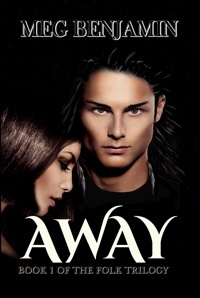Meg Benjamin's Blog, page 4
June 5, 2020
Wild Love Out Now
The long-awaited (well I waited a long time!) third book in the Brewing Love Trilogy is now available. Here’s the blurb.
After one bad relationship too many, Peaches Guidry came to the mountain resort town of Antero, Colorado to start over. Now, she’s manager of a great restaurant and on her way to bigger and better things without anyone complicating her life. The upcoming grand opening of the local brewery’s new pub is the perfect opportunity to introduce more customers to her menu. A partnership with Antero Brewing could bring her business to a whole new level.
But then Colin Brooks strolls into town. Rugged, yet charismatic. The bad boy with a heart of gold—the kind of man she can’t resist.
Her friends at the brewpub, though, are quick to tell her Colin isn’t exactly new in town. He’s the black sheep of Antero and disappeared years ago without a word. Now he’s back and hoping to prove he’s changed, but the welcome they give him is harsher than the winter winds.
She knows she shouldn’t be falling for someone that everyone says can’t be trusted. And getting tangled up in his wild past could ruin the future of everything she’s worked so hard to build… So why can’t they stay away from each other?
March 24, 2020
February 10, 2019
October 5, 2018
May 8, 2018
Away: Magical Research
 I started writing the Folk series (Book 1, Away, is available for preorder now) a while ago, knowing nothing about fairies beyond the usual. And by “the usual” I mean pretty much Midsummer Night’s Dream and a very obscure Kipling children’s book called Puck of Pook’s Hill. I knew I needed to do some research on the subject, although I hadn’t much of a clue how to start. Googling fairies gets you over 150 million results.
I started writing the Folk series (Book 1, Away, is available for preorder now) a while ago, knowing nothing about fairies beyond the usual. And by “the usual” I mean pretty much Midsummer Night’s Dream and a very obscure Kipling children’s book called Puck of Pook’s Hill. I knew I needed to do some research on the subject, although I hadn’t much of a clue how to start. Googling fairies gets you over 150 million results.
Enter Anna Franklin. Her Illustrated Encyclopaedia of Fairies is a delight, as well as essential reading for somebody like me. She covers everything from generic topics like spinning/weaving (important in book 2, Unseen) or clothes to the most esoteric, like Havfine (Norwegian mermaids) or Medb (an Irish succubus). After spending some time with Franklin, I decided I wanted to bring a variety of European fairies to America—why wouldn’t fairies emigrate like their non-supernatural cousins?
I concentrated on groups of fairies who lived in mountains or woodlands, since I figured those were the beings who’d most likely gravitate toward the Rockies. Kobolds were a natural. They’re northern European mine fairies, and the name derives from coboldus, Latin for mountain spirit. My present-day Kobolds live in Nederland, an actual town in the mountains above Boulder. The hero of Away, Grim Morrigan, is half Kobold, although he’s not all that fond of his relatives, who own a sand and gravel business. Another group of mountain fairies were the Barbegazi, who come from the Italian Alps. In their natural setting they hibernate in the summer and only come out when the temperature drops below freezing. My Barbegazi have adapted to their Colorado home, but they do get into a bit of trouble over a freezing spell they’ve developed that they unleash in a bar bet. I also introduced Doonies and Dunters, Scottish fairies who live in the borderlands, and Silvani, another branch of Italian woodland fairies. I played a little fast and loose with the Doonies, making them a bit more redneck than they are in their traditional roles. But I figured their New World versions might be a bit less orthodox than their Highland counterparts.
These mountain and woodland fairies are all well settled in Colorado and environs, but I also found a couple of groups who might not be so happy to be here. Seelies are the aristocrats of Scottish fairies, and the Seelies in Away are far from delighted with their status in the New World, which they see as a definite come-down. They’re the bullies of the Folk. The Folletti are Italian fairies closely related to succubi. The ones in legend are male, but mine are female and the descendants of courtesans. They’d probably be much happier in Rome or Milan than they are in the foothill suburbs of Denver, which don’t feature too many billionaires. And as we all know from generations of folktales, unhappy fairies cause mischief.
I really enjoyed the world building in the Folk; the characters were great fun to work with. I hope you’ll enjoy stepping into their world, too. After all, the message of the Folk is clear: you never know what’s going on just beneath the surface. Maybe your next-door neighbor is a Kobold or the couple down the street are Silvani (the women are Silvane). With the Kobold, you can always check his feet—they’re supposed to be oversize. But maybe they won’t look any different—maybe they’ve evolved in a new way.
You never can tell.
April 24, 2018
April 19, 2018
Back To the Dark Side
 I write contemporary romance, for the most part. Of my eighteen published novels, fifteen are contemporary. The other three, however, are paranormal—the Ramos Family Trilogy that I wrote for Berkley InterMix about a family of mediums in San Antonio. That trilogy was so much fun to write that I’ve always had a secret wish to do more paranormal stories. And now I have.
I write contemporary romance, for the most part. Of my eighteen published novels, fifteen are contemporary. The other three, however, are paranormal—the Ramos Family Trilogy that I wrote for Berkley InterMix about a family of mediums in San Antonio. That trilogy was so much fun to write that I’ve always had a secret wish to do more paranormal stories. And now I have.
My new Folk series for Soul Mate Publishing isn’t about mediums. It’s about fairies. Okay, I can hear the eye rolls from here, but bear with me. My fairies aren’t Shakespeare’s fairies. They’re the Folk: a group of clans who migrated to the USA from Europe several generations ago. They look and act like everybody else, but they’re not. Each clan has a set of magical abilities which they’re supposed to keep secret from “mortals” like us. There’s also a hidden hierarchy of governance for the clans, all the way up to a royal family that has a palace in Interlocken, Colorado (by a strange coincidence, that’s a suburb only a few miles from my house).
The Folk are human, mostly. But they can do a few unusual things, like spells that will freeze beer or power blasts that can send a person flying across the room. The hero of Book 1, Away, is Grim Morrigan, a member of the Folk police force, the Ward. Grim’s job is trying to enforce the rules, to keep the Folk under the radar, something the individual clans aren’t always good about. His life is fairly routine until he encounters Annie Duran, a waitress at one of the local clubs who saw her brother in the parking lot one night—the same brother who had disappeared into a mountain cave ten years ago.
As Annie and Grim work together to discover what happened to her brother, they uncover a conspiracy with dark roots and sinister implications. They also meet a variety of colorful characters, including a prince with a bit of satyr in his bloodlines.
On this blog, I’ll be talking a lot about those colorful characters and about how I researched the Folk and their clans. Like the Ramos books, the Folk books mix real and fantastic. The locations for Away feature lots of places around the foothill suburbs of Denver where I live, but, of course, the things that happen there are a far cry from my normal daily routine.
I had a wonderful time creating the Folk, and I hope to go on working with them for a while. You can preorder Away now; it’ll be released on May 23.
March 28, 2018
The Billionaire Problem
 The billionaire plot has been a familiar romance trope for a lot of years. In the usual plot line, the ruthless billionaire falls in love with a decidedly less rich heroine who teaches him that money isn’t everything. In its bare outlines, it’s close to a fairy tale: a poor woman (it’s almost always the heroine who’s poor) being swept away by a wealthy man who’ll make all of her problems disappear. It’s also reminiscent of all the folk tales about princes falling in love with commoners who showed more courage and good sense than their aristocratic counterparts. The plot is so widespread and recognizable that publishers like Harlequin put billionaire in the titles of their books to alert the readers to the subgenre: The Billionaire’s Kitten, Billionaire Neighbor, and Billionaire Unloved are all current titles from Amazon.
The billionaire plot has been a familiar romance trope for a lot of years. In the usual plot line, the ruthless billionaire falls in love with a decidedly less rich heroine who teaches him that money isn’t everything. In its bare outlines, it’s close to a fairy tale: a poor woman (it’s almost always the heroine who’s poor) being swept away by a wealthy man who’ll make all of her problems disappear. It’s also reminiscent of all the folk tales about princes falling in love with commoners who showed more courage and good sense than their aristocratic counterparts. The plot is so widespread and recognizable that publishers like Harlequin put billionaire in the titles of their books to alert the readers to the subgenre: The Billionaire’s Kitten, Billionaire Neighbor, and Billionaire Unloved are all current titles from Amazon.
But in 2018, the idea of the billionaire who only needs love to blossom into a decent human being is becoming increasingly hard to swallow, at least for some of us. These are the days of Billionaires Behaving Badly, after all. The convention of the darkly handsome billionaire who wants to sweep a woman off her feet comes up against the reality of Martin Shkreli, the billionaire who jacked up the price of the AIDS medicine his firm produced from thirteen dollars per pill to 750 dollars per pill (AIDS sufferers take ten to fifteen pills a day). Shkreli reacted to the resulting public outcry with a smirk, and I’ve never seen a picture of him that made him seem anywhere close to attractive. Even his lawyer in an unrelated criminal matter said he’d like to punch him. Then there are the billionaires who fund shady political concerns, like Robert Mercer, funder of Cambridge Analytica, Breitbart News, and other extreme rightwing causes. Or Foster Friess, who recommended that women use aspirin for birth control as they did in the Good Ol’ Days: “The gals put it between their knees, and it wasn’t that costly.” Talk about someone you’d like to punch. And, of course, there’s the Billionaire In Chief, about whom I’ll say little other than express my devout hope that if nude photos exist, I never have to look at them.
It’s hard to find any of these men even vaguely romantic. And it’s hard to accept the romance version of these jerks. With the exception of men like Warren Buffett, most of the billionaires in the limelight today are reprehensible creeps. Their money can’t make up for their total lack of character or sensitivity. Mark Zuckerburg and Bill Gates may both fund lots of charities, but their professional activities still raise eyebrows.
So what becomes of the billionaire trope? My guess is nothing. After all, romance writers still create dashing heroes who are dukes or earls, despite the lack of real life models. And I’m sure more adaptable readers than I will continue to buy billionaire books and ignore their lack of realistic counterparts. But my guess is we’ll also continue to see a rise in a counter-trend: the billionaire as villain. Murderous billionaires, billionaires out to destroy the environment, billionaires bent on wrecking historic monuments for profit—they’re all available to play antagonist to the hero or heroine. And for me that’s a lot more realistic.
Finally, I should stress that the presence of billionaire heroes doesn’t mean either romance readers or writers are prone to excuse the misdeeds of actual billionaires in public life. Although critics love to imply that female readers of romance have a distorted view of reality, there’s no evidence that most of us have any difficulty telling the difference between truth and fiction. A romance reader can devour a billionaire romance one day and take her place at the pussy-hat barricades the next. Billionaires only get a bye in fiction.
March 21, 2018
(In)elegant Variation
 I suppose it was inevitable that editing apps would become available eventually. After all, pattern recognition is something computers do very well, and a lot of copyediting comes under the heading of recognizing and, in some cases, changing authorial patterns of language. For example, most of us have words we habitually overuse. Some authors keep lists of these words and then do global searches to eliminate some of them before submitting a manuscript. Editing programs take that step much farther. The most common kind of analysis they offer gives the author a list of frequently repeated words—often words like that or then that may constitute “filler”—that provide little in the way of meaning but take up space.
I suppose it was inevitable that editing apps would become available eventually. After all, pattern recognition is something computers do very well, and a lot of copyediting comes under the heading of recognizing and, in some cases, changing authorial patterns of language. For example, most of us have words we habitually overuse. Some authors keep lists of these words and then do global searches to eliminate some of them before submitting a manuscript. Editing programs take that step much farther. The most common kind of analysis they offer gives the author a list of frequently repeated words—often words like that or then that may constitute “filler”—that provide little in the way of meaning but take up space.
Unfortunately, revising repetition can lead to what grammarians used to call elegant variation, a flaw that comes from overreacting to repetition in the first place. Elegant variation happens when a writer tries to avoid repeating a word by using somewhat outlandish synonyms. H. W. Fowler first came up with the phrase in 1920 for his Modern English Usage, and it’s been cited by numerous other writing authorities since (although some have referred to it more accurately as inelegant variation). Lots of examples have been cited by editors, including using “popular orange vegetable” to refer to a carrot and “succulent bivalve” as a synonym for oyster.
These examples, I submit, are pretty bad, but they’re also less than common these days. More frequently writers deal with repetition by going to the thesaurus tool in their word processors and grabbing a similar word to fill in. However, the problem here is that synonyms rarely have precisely the same meaning as the original word. Sometimes that doesn’t matter. Dispute and argument are close enough in meaning that using one for the other probably won’t make much difference. But sometimes plugging in a synonym means that the sentence no longer says precisely what you want it to say. Grimace and frown don’t mean the same thing, and they don’t call up the same image. Plugging one in is likely to leave you dissatisfied with the result.
Cutting back on repetition can be a necessary step in editing. But concentrating on repetition to the exclusion of other types of revision can lead to frustration for the author and a manuscript that still needs work even after an exhaustive rewrite. And all of this repetition business overlooks a larger issue. Repetition is only one aspect of style, and I’d argue it’s not a major one. Sentence structure, sentence variation, consistent voice and point of view, level of diction—all of these things are as important as repetition and many of them are more so. And that doesn’t begin to consider the truly major considerations of plot, character, theme, and central conflict. Without attention to those things, taking care of repetition will get you nowhere.
This is my main concern about editing programs: they may give authors, particularly inexperienced authors, a false sense of security. After all, you’ve taken care of eighteen often repeated words. That’s it, right? Well, probably not. Pattern recognition can give you some helpful advice, but it can’t really take the place of a human editor. Somebody needs to be able to say (as one famous writer once said to another), “It’s crap, honey. Do it again.”
March 14, 2018
Not Doing Sex
 In my last post I talked about the trials and pleasures of writing sex scenes in historical romances, and in my introduction I said that all romance novels have sex scenes. Of course, that isn’t actually the case. So consider this post a sort of footnote to the last one.
In my last post I talked about the trials and pleasures of writing sex scenes in historical romances, and in my introduction I said that all romance novels have sex scenes. Of course, that isn’t actually the case. So consider this post a sort of footnote to the last one.
Some romance novels don’t include sex scenes. In fact, some romance novels don’t even include the hero and heroine holding hands. The amount of physical contact allowed between the two depends largely on the type of romance being written, ranging from only verbal affirmations of love through sexual practices that might make Christian Grey blush. At the less physical end of things you have two main categories: Inspirational Romance and Sweet Romance.
Inspirational romance novels include a religious/spiritual dimension and have very strict requirements for what can and can’t take place between hero and heroine, depending on the publisher. The target readers for these romances are religious conservatives who reject premarital sexual experience. Thus while these novels center on a love story (hey, it’s a romance), the hero and heroine usually don’t kiss. And they may have no physical contact at all. Their romance takes place at a respectful distance and it may involve a spiritual crisis.
Sweet romance maintains the no-sex rule while sidestepping the religious content. Hero and heroine will be attracted to each other, and according to the rules of the publisher or the author, they may share a few chaste kisses. But there will be no bedroom scenes.
Another grouping here is less a formal category like inspirational and more a set of practices. Let’s call them the closed bedroom door books. Here the hero and heroine have sex but that sex isn’t described. We see the afterglow but not the main event, as it were. Cozy mysteries frequently fall into this category—the heroine in Donna Andrews mysteries definitely gets it on with her leading man husband, but their trysts happen off stage. The focus here is more on the mystery than the relationship.
All these categories have clear conventions and an equally clear target audience, but some readers may move back and forth. I don’t usually read inspirationals, for example, but I read cozy mysteries frequently, and I’m guessing some of my readers also read books where the bedroom door is firmly closed.
Which leads me to one final category, so-called “clean” romance. This isn’t exactly an “official” category—you won’t find it in RWA, for example, and a recent dustup in RWA Professional Authors Network shows that I’m not the only author who dislikes the terminology. But some writers and some publishers use it to describe themselves. As far as I can tell, “clean” romance is another name for sweet romance, and of the two I (and most other mainstream authors) much prefer the latter. Neither sweet romance nor inspirational romance have pejorative implications. “Clean” romance most definitely does. By this standard, those of us who include sex scenes write “dirty” romance or, even worse, “unclean” romance. That’s not only pejorative, it’s more than a little annoying. My reaction to this is pretty straightforward: bullshit. Some “clean” writers have argued that the opposite of “clean” is “steamy”, but that’s pretty clearly inaccurate. The opposite of “steamy” is “cold.” If the “clean” writers want to rebrand themselves as writing cold romance, that’s fine with me.
When you consider how much crap the romance community puts up with anyway—the constant putdowns from male critics, the implication that romance is somehow more trashy than other genres of popular fiction, the sneers directed at romance readers who supposedly can’t tell the difference between reality and fiction—it’s particularly annoying to have romance writers themselves taking shots at each other. Sweet romance and inspirational romance both have well-defined audiences, as do the rest of us, but we’re all part of the same genre. More power to us.



